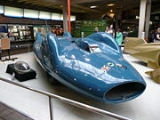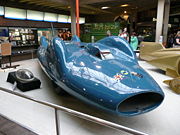
Bluebird-Proteus CN7
Encyclopedia

Land speed record
The land speed record is the highest speed achieved by a wheeled vehicle on land. There is no single body for validation and regulation; in practice the Category C flying start regulations are used, officiated by regional or national organizations under the auspices of the Fédération...
-breaking car, driven by Donald Campbell
Donald Campbell
Donald Malcolm Campbell, CBE was a British speed record breaker who broke eight world speed records in the 1950s and 1960s...
, built in 1960 and rebuilt in 1962.
Design
In 1956, Campbell began planning a car to break the land speed record, which then stood at 394 mph (630 km/h). The Norris brothers, who had designed Campbell's highly successful Bluebird K7Bluebird K7
Bluebird K7 was a turbo jet-engined hydroplane with which the United Kingdom's Donald Campbell set seven world water speed records during the 1950s and 1960s. Campbell lost his life in K7 on January 4, 1967 whilst making a bid to raise the speed record to over on Coniston Water.-Design:Donald...
hydroplane designed Bluebird-Proteus CN7 with 500 mile per hour in mind. The car weighed in at 4 tons and was built with an advanced aluminum honeycomb sandwich of immense strength, with fully independent suspension. The car had 4 wheel drive, through 52 inch Dunlop
Dunlop Rubber
Dunlop Rubber was a company based in the United Kingdom which manufactured tyres and other rubber products for most of the 20th century. It was acquired by BTR plc in 1985. Since then, ownership of the Dunlop trade-names has been fragmented.-Early history:...
wheels / tyres, air brakes as well as all round inboard disc brake
Disc brake
The disc brake or disk brake is a device for slowing or stopping the rotation of a wheel while it is in motion.A brake disc is usually made of cast iron, but may in some cases be made of composites such as reinforced carbon–carbon or ceramic matrix composites. This is connected to the wheel and/or...
s. The CN7 (Campbell-Norris 7) was built by Motor Panels
James Milner Phillips
James Milner Phillips was an English automotive engineer and businessman who supervised the building, testing and world land speed record attempts of Donald Campbell's Bluebird-Proteus CN7 which on 17 July 1964 became the fastest four-wheeled vehicle in the world.Phillips was managing director of...
in Coventry, and was completed by the spring of 1960, and was powered by a Bristol-Siddeley Proteus
Bristol Proteus
|-See also:-Bibliography:* Gunston, Bill. World Encyclopedia of Aero Engines. Cambridge, England. Patrick Stephens Limited, 1989. ISBN 1-85260-163-9* Hooker, Sir Stanley. Not Much Of An Engineer. Airlife Publishing, 1985. ISBN 1853102857....
free-turbine (turboshaft
Turboshaft
A turboshaft engine is a form of gas turbine which is optimized to produce free turbine shaft power, rather than jet thrust...
) engine of 4450 shp.
Engine
The Bristol-Siddeley Proteus was the Bristol Aeroplane CompanyBristol Aeroplane Company
The Bristol Aeroplane Company, originally the British and Colonial Aeroplane Company, was both one of the first and one of the most important British aviation companies, designing and manufacturing both airframes and aero engines...
's first successful gas-turbine engine design, a turboprop that delivered over 4,000 hp (3,000 kW). The Proteus was a two spool, reverse flow gas turbine. Because the turbine stages of the inner spool drove no compressor stages, but only the propeller, this engine is sometimes classified as a free turbine. The engine, a Proteus 705, was specially modified to have a drive shaft at each end of the engine, to separate fixed ratio gearboxes on each axle.
Goodwood, 1960
Campbell demonstrated his Bluebird CN7 Land Speed Record car at Goodwood CircuitGoodwood Circuit
Goodwood Circuit is an historic venue for both two- and four-wheeled motorsport in the United Kingdom. The 2.4 mile circuit is situated near Chichester, West Sussex, close to the south coast of England, on the estate of Goodwood House, and completely encircles Chichester/Goodwood Airport...
in July 1960, at its initial public launch and again in July 1962. The laps of Goodwood were effectively at 'tick-over' speed, because the car had only 4 degrees of steering lock, with a maximum of 100 mph on the straight on one lap.
Bonneville, 1960
Following the low-speed tests conducted at Goodwood, the CN7 was taken to the Bonneville Salt Flats in Utah, USA, scene of his father's last LSR triumph in 1935. The attempt, which was heavily sponsored by BPBP
BP p.l.c. is a global oil and gas company headquartered in London, United Kingdom. It is the third-largest energy company and fourth-largest company in the world measured by revenues and one of the six oil and gas "supermajors"...
, Dunlop
Dunlop Rubber
Dunlop Rubber was a company based in the United Kingdom which manufactured tyres and other rubber products for most of the 20th century. It was acquired by BTR plc in 1985. Since then, ownership of the Dunlop trade-names has been fragmented.-Early history:...
as well as many other British motor component companies, was unsuccessful and CN7 was written off following a high-speed crash on the 16th of September. Campbell suffered a fracture to his lower skull, a broken ear drum as well as cuts and bruises. He convalesced in California until November 1960. Meanwhile plans had been put in motion to rebuild CN7 for a further attempt.
His confidence was severely shaken, he was suffering mild panic attacks, and for some time he doubted whether he would ever return to record breaking. As part of his recuperation he learned to fly light aircraft and this boost to his confidence was an important factor in his recovery. By 1961 he was on the road to recovery and planning the rebuild of CN7.
Lake Eyre, 1963
The rebuilt car was completed, with modifications including differential locks and a large vertical stabilising fin, in 1962. After initial trials at Goodwood and further modifications to the very strong fiber-glass cockpit canopy, CN7 was shipped this time to Australia for a new attempt at Lake EyreLake Eyre
Lake Eyre is the lowest point in Australia, at approximately below sea level, and, on the rare occasions that it fills, it is the largest lake in Australia and 18th largest in the world...
in 1963. The Lake Eyre location was chosen as it offered 450 square miles (1,165.5 km²) of dried salt lake, where rain had not fallen in the previous 20 years, and the surface of the 20 miles (32 km) long track was as hard as concrete. As Campbell arrived in late March, with a view to a May attempt, the first light rain fell. Campbell and Bluebird were running by early May but once again more rain fell, and low-speed test runs could not progress into the higher speed ranges. By late May, the rain became torrential, and the lake was flooded. Campbell had to move the CN7 off the lake in the middle of the night to save the car from being submerged by the rising flood waters. The 1963 attempt was over.
Campbell received very bad press following the failure to set a new record, but the weather conditions had made an attempt out of the question. BP pulled out as a sponsor at the end of the year.
Lake Eyre, 1964
Campbell and his team returned to Lake Eyre in 1964, with sponsorship from Australian oil company AmpolAmpol
Ampol, the Australian Motorists Petrol Company, was incorporated by Sir William Gaston Walkley in 1936 in New South Wales. This was in response to Australians' concerns about perceived inequitable petrol pricing, and allegations of transfer pricing by foreign oil companies to limit their tax...
, but the salt surface never returned to the promise it had held in 1962 and Campbell had to battle with CN7 to reach record speeds (over 400 mph (178.8 m/s)). After more light rain in June, the lake finally began to dry enough for an attempt to be made. On July 17, 1964, Campbell set a record of 403.1 mph (180.2 m/s) for a four-wheeled vehicle (Class A). Campbell was disappointed with the record speed as the vehicle had been designed for 500 mph (223.5 m/s) CN7 covered the final third of the measured mile at an average of 429 mph (191.8 m/s), peaking as it left the measured mile at over 440 mile per hour. Had the salt surface been hard and dry, and the full 15 mile length originally envisaged, there can be no doubt that CN7 would have set a record well in excess of 450 mph (201.2 m/s) and perhaps close to her design maximum of 500 mph (223.5 m/s), a speed that no other wheel driven car has approached.
Campbell commissioned the author John Pearson
John Pearson
John Pearson may refer to:* John A. Pearson , Canadian architect* John Pearson , English master-craftsman* John Pearson , British author...
to chronicle this attempt, with the resultant critically acclaimed book Bluebird and the Dead Lake, published by Collins in 1965.
After the record
To celebrate the record, Campbell drove CN7 through the streets of the South Australian capital, AdelaideAdelaide
Adelaide is the capital city of South Australia and the fifth-largest city in Australia. Adelaide has an estimated population of more than 1.2 million...
, to a presentation at city hall before a crowd of in excess of 200,000 people. CN7 was then displayed widely in Australia and the UK after her return in November 1964.
In June 1966, CN7 was demonstrated at RAF Debden
RAF Debden
RAF Debden is a former RAF airfield in England. The field is located 3 miles SE of Saffron Walden and approximately 1 mile north of the village of Debden in North Essex.-RAF Fighter Command:...
in Essex, with a stand in driver, Peter Bolton. He crashed the car during a medium speed run, causing damage to her bodywork and front suspension. The car was patched up and Campbell ran her at a much lower speed than he intended. Campbell continued with his plans for the rocket-powered car Bluebird CMN-8
Bluebird CMN-8
Bluebird Mach 1.1 was a design for a rocket-powered supersonic land speed record car, planned by Donald Campbell but thwarted by his subsequent death during a water speed record attempt in Bluebird K7 in early 1967....
with a view to raising the LSR towards Mach 1
Mach 1
Mach 1 can refer to:* The speed of sound* M.A.C.H. 1, a comic strip* Mach 1, a novel by Allen Adler* Mach 1 Racing, a former NASCAR team...
. In January 1967, he was killed in his water-speed record jet hydroplane Bluebird K7
Bluebird K7
Bluebird K7 was a turbo jet-engined hydroplane with which the United Kingdom's Donald Campbell set seven world water speed records during the 1950s and 1960s. Campbell lost his life in K7 on January 4, 1967 whilst making a bid to raise the speed record to over on Coniston Water.-Design:Donald...
.
CN7 was eventually restored in 1969, but has never run again in anger. In 1969, Campbell's widow, Tonia Bern-Campbell negotiated a deal with Lynn Garrison
Lynn Garrison
Lynn Garrison is a Canadian pilot and political adviser. He was an RCAF fighter pilot from the 403 City of Calgary Squadron, commercial pilot, film producer, director and mercenary...
, President of Craig Breedlove and Associates, that would see Craig Breedlove
Craig Breedlove
Craig Breedlove is a five-time world land speed record holder. He was the first to reach , , and , using several turbojet-powered vehicles, all named Spirit of America.-Land vehicle speed records :...
run Bluebird on Bonneville's Salt Flats. This concept was cancelled when the parallel Spirit of America supersonic car project failed to find support.
It became a permanent exhibit at the National Motor Museum, Beaulieu, England in 1972, and is still on display there.

